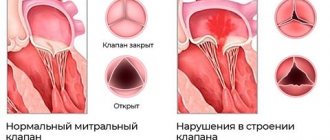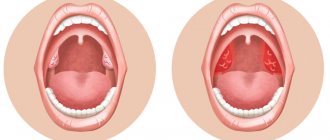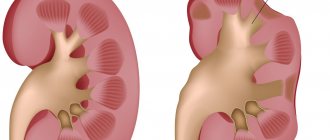Patient complaints can vary from mild malaise and unexpressed chest pain to a fulminant course leading to acute heart failure and sometimes death. Most often, the initial complaints are of the nature of a flu-like syndrome: fever, pain in muscles and joints, sometimes symptoms of damage to the gastrointestinal tract such as gastroenteritis
- chest pain, usually long-term, not associated with physical activity, of various types
- palpitations, almost constant, often interruptions in heart function, various arrhythmias
- shortness of breath, decreased exercise tolerance
- weakness, which may be the leading and almost the only complaint.
Myocarditis - symptoms and treatment
Viral infection plays a key role in the development of active myocarditis.
Phases of myocarditis development:
- Penetration of cardiotropic viruses (Coxsackie, mumps, parvovirus B19, adenovirus, etc.) or other infectious agents into the myocardium. Viruses enter cardiomyocytes, the muscle cells of the heart, multiply and cause their death. As a result of the direct action of viruses, the immune system is activated. The first phase of the disease, with an adequate immune response, ends with victory over the viruses or transition to the second phase.
- Autoimmune reactions occur, cardiomyocytes are destroyed under the influence of immune cells.
- Remodeling (modification) of the myocardium occurs—structural changes in the heart muscle [8].
Depending on the characteristics of the body’s defense mechanisms and the characteristics of the pathogen, one or another phase of the disease may predominate.
Normal immune reactivity helps eliminate the virus and allows the damaged myocardium to heal. However, immune disorders can lead to an imbalance: the body either fails to eliminate the virus, or favorable conditions are created for the cells of the immune system to remain in the heart muscle for a long time. Cells of the immune system secrete cytokine proteins that destroy cardiomyocytes.
In the mechanism of development of viral myocarditis, key factors are identified: the direct damaging effect of viruses, which leads to acute and chronic autoimmune reactions, and subsequent cardiac remodeling.
It has been established that remodeling of the heart muscle is the main link in the pathogenesis of the development of heart failure in myocarditis. In this process, the left ventricle is first affected, then the right parts of the heart are involved. Changes in cardiac geometry occur in the initial stages of myocarditis and progress with chronic inflammation [2].
In severe cases of the disease, the myocardium is damaged as a result of apoptosis of cardiomyocytes - programmed cell death. The more cardiomyocytes that show signs of apoptosis, the higher the risk of developing fatal heart failure in acute myocarditis [6].
Circulatory disorders with viral myocarditis go through three phases:
The first phase is hyperdynamic. Develops within 1-3 days after infection. During this phase, myocardial contractility increases, the volume of blood that the heart pumps per minute (minute volume) increases, as the activity of the sympathetic division of the autonomic nervous system increases. Also in this phase, diastolic dysfunction of the heart muscle develops - a violation of myocardial relaxation. There is slight damage to cardiomyocytes as a result of exposure to viruses and mediators of the immune system. There are no pronounced pathological changes in cardiac cells yet.
The second phase is depressive. Occurs between 4 and 7 days after infection. During this phase, a decrease in contractility, cardiac output, and impaired myocardial relaxation progresses. On the 5th day, dilatation (expansion) of the left ventricle develops. On the 7th day, cardiogenic shock and severe manifestations of venous stagnation may occur. In this phase, the virus continues to damage cardiomyocytes, and active damage to cardiomyocytes by cytokines is also observed. Edema develops, the myocardium becomes saturated with inflammatory cells, which leads to an increase in diastolic dysfunction of the left ventricle (impaired relaxation).
The third phase is recovery. If the course is favorable, recovery begins between 9 and 14 days. Intercellular edema and inflammation are reduced, which leads to a partial restoration of myocardial contractility and the compliance of the left ventricular cavity to stretching [1].
Myocarditis
The acute stage of myocarditis requires hospitalization in the cardiology department, limitation of physical activity, strict bed rest for 4 - 8 weeks until circulatory compensation is achieved and normal heart sizes are restored. A diet for myocarditis involves limited consumption of table salt and liquid, enriched protein and fortified foods to normalize metabolic processes in the myocardium.
Myocarditis therapy is carried out simultaneously in four directions, providing etiological, pathogenetic, metabolic symptomatic treatment. Etiological treatment is aimed at suppressing the infectious process in the body. Treatment of bacterial infections is carried out with antibiotics after isolation and determination of the sensitivity of the pathogenic microorganism. For myocarditis of viral origin, the prescription of antiviral drugs is indicated.
A necessary condition for the successful treatment of myocarditis is the identification and sanitation of infectious foci that support the pathological process: tonsillitis, otitis, sinusitis, periodontitis, adnexitis, prostatitis, etc. After sanitization of the foci (surgical or therapeutic), a course of antiviral or antibacterial therapy, microbiological monitoring of cure is necessary .
The pathogenetic therapy of myocarditis includes anti-inflammatory, antihistamine and immunosuppressive drugs. The prescription of non-steroidal anti-inflammatory drugs is carried out individually, with the selection of dosages and duration of treatment; The criterion for withdrawal is the disappearance of laboratory and clinical signs of inflammation in the myocardium. In severe, progressive myocarditis, glucocorticoid hormones are prescribed. Antihistamines help block inflammatory mediators.
To improve the metabolism of the heart muscle in myocarditis, potassium preparations, inosine, vitamins, ATP, and cocarboxylase are used. Symptomatic treatment of myocarditis is aimed at eliminating arrhythmias, arterial hypertension, symptoms of heart failure, and preventing thromboembolism. The duration of treatment for myocarditis is determined by the severity of the disease and the effectiveness of complex therapy and averages about six months, and sometimes longer.
Symptoms
The signs of myocarditis are extensive and completely depend on the form, course and degree of development of the pathology. The development of the disease is divided into several groups:
- According to the form of the course: acute, chronic and rapid.
- By localization: focal and diffuse.
- By severity: light, medium and severe.
With any type of myocarditis, patients have several similar symptoms: chronic fatigue, general weakness, pain in the chest and under the left shoulder blade, increased sweating, shortness of breath.
An expanded group of signs indicates the presence of a certain type of myocarditis:
• Minor symptoms are characteristic of infectious-allergic myocarditis. The patient experiences slight weakness, perceived more as a consequence of fatigue than as a symptom of a dangerous disease. Taking vitamins and aspirin, a person does not even think about the fact that dangerous inflammatory processes are occurring in the body.
• Idiopathic or rheumatic myocarditis is manifested by acute, burning pain in the heart and left arm. The clinical picture is similar to ischemic heart disease - lethargy, limited motor function, constant lack of air, and in some cases, night fever.
• Diffuse localization of the inflammatory process affecting the entire myocardium is characterized by acute heart failure and its characteristic symptoms. Swelling appears, bruises under the eyes, limbs go numb and acquire a bluish tint.
• Bacterial myocarditis is characterized by disruption of the circulatory system. There is a high risk of blood clots forming in the main arteries of the heart. It manifests itself as a change in the color of the skin, shortness of breath, even during rest, and constant aching pain behind the sternum.
The severity of the pathology is completely reflected in the appearance of the patient. At the initial stages of the inflammatory process, no visible changes are observed. The patient may complain to the attending physician about general weakness. As the disease worsens, the patient's lips become blue, the limbs become pale, and swelling occurs under the eyes. In the severe form, swollen veins in the neck and arms, a painful dry cough, and shortness of breath are clearly visible, interfering with the usual activities.
Important! If any of these signs appear, you should immediately seek medical help. It is especially important to do this after suffering from infectious diseases.
Who is at risk
The most common cause of myocarditis is viral pathologies of various origins. Therefore, the risk group includes every person who has had herpes, hepatitis B, C, rubella, chicken pox, measles, diphtheria and even influenza. Since most people have been diagnosed with some kind of viral disease, everyone must undergo a preventive examination in order to exclude the presence of inflammatory processes in the heart. This can subsequently save lives.
The risk of developing myocarditis increases in proportion to the presence of infectious pathologies. Listening to your heart is recommended for everyone who has suffered or is a carrier of diseases caused by the following pathogens:
- Bacteria that provoke the development of tuberculosis, chlamydia, staphylococcus.
- Fungal genus Aspergillus fumigatus and Candida. They cause such common diseases as tonsillitis, laryngitis, otitis media, conjunctivitis, candidiasis, etc.
- Parasitic worms - roundworms, echinococci, trichinella, lamblia, toxocariasis.
- Diabetes mellitus in any degree.
- Thyroid diseases.
- Autoimmune pathologies – rheumatoid arthritis, lupus erythematosus, vasculitis.
The risk group includes people whose professional activities involve working in enterprises with hazardous working conditions, where there is a possibility of heavy metal poisoning. Taking certain medications can cause inflammation of the myocardium. For example, antiallergic cephalosporins or antidepressants have an extremely negative effect on cardiac activity. Social factors play an important role for the myocardium. Abuse of alcoholic beverages, smoking and other dangerous and harmful addictions contribute to the development of myocarditis.
Consultation and examination with a cardiologist
IMMA medical clinics have modern equipment and their own laboratories to accurately determine myocarditis in the initial stages. The full range of studies includes an initial examination by a qualified cardiologist, clarifying tests, and diagnostic measures using modern technologies. Diagnosis and treatment of myocarditis in children and adults takes place in equipped clinics, trained by experienced personnel, under the guidance of leading cardiologists.
To make an appointment, use the contacts listed on the website. The professional staff of the clinic will provide all possible information support.
1.What is myocarditis and its causes?
Myocarditis is inflammation of the heart muscle
. A disease that affects thousands of people every year, although the actual numbers are not exactly known because sometimes the disease is asymptomatic. Myocarditis can be caused by infections and other problems, and the disease can also occur in those people who have never complained about their heart. Therefore, the best way to prevent myocarditis is the prevention and timely treatment of infectious diseases.
Causes of myocarditis
Myocarditis most often develops due to a viral infection.
. When the body is infected, it produces special cells that fight the infection. These cells secrete special chemicals. If such a cell gets into the heart, it can release chemicals that can negatively affect the heart muscle - the heart thickens, swells and weakens. Timely consultation with a doctor at the first signs of infection can prevent the development of such complications.
Here are just some types of infections
which can cause myocarditis:
- Cytomegalovirus;
- Epstein-Barr virus;
- Hepatitis C;
- Herpes;
- HIV;
- Bacterial infections
- Chlamydia (a common sexually transmitted disease);
- Mycoplasmas;
- Streptococcal bacteria (Streptococcus);
- Staphylococcal bacteria (staphylococcus);
- Treponema (cause of syphilis);
- Fungal and parasitic infections.
Myocarditis can be caused not only by exposure to a virus. To other reasons
Myocarditis includes a reaction to certain
chemicals or allergic reactions
to medications and toxins (alcohol, drugs, lead, snake bites, spider bites, wasp bites), chemotherapy, or radiation therapy.
Autoimmune diseases
such as lupus or rheumatoid arthritis, which cause inflammation throughout the body, can also lead to myocarditis.
A must read! Help with treatment and hospitalization!
2. Signs and symptoms of the disease
The peculiarity of myocarditis is that the disease is often asymptomatic. And most people recover without knowing they had myocarditis. If symptoms of the disease do exist, they may be as follows:
- Shortness of breath during physical exertion, and subsequently at rest, at night when lying down;
- Abnormal heartbeat, in rare cases leading to fainting;
- Delirium;
- Sharp or stabbing pain in the chest, pressure in the chest that may extend to the neck and shoulders;
- Fatigue;
- Common signs of infection are fever, muscle pain, sore throat, headache;
- Diarrhea;
- Joint pain;
- Swollen joints, swelling of the legs;
- Fluid retention in the body (impaired urination).
If you experience these symptoms, you should contact a good doctor who will examine you and, among other things, check for palpitations, fluid accumulation in the lungs or swelling of the legs - signs that may indicate myocarditis.
Visit our Cardiology page








